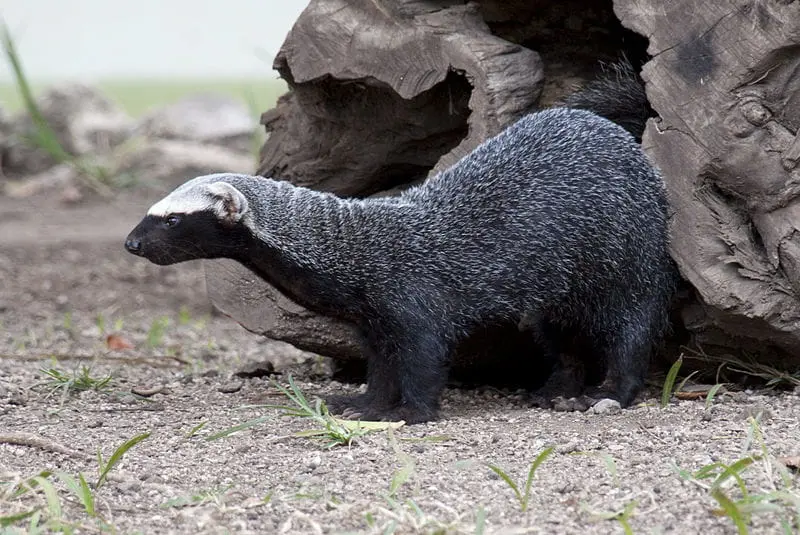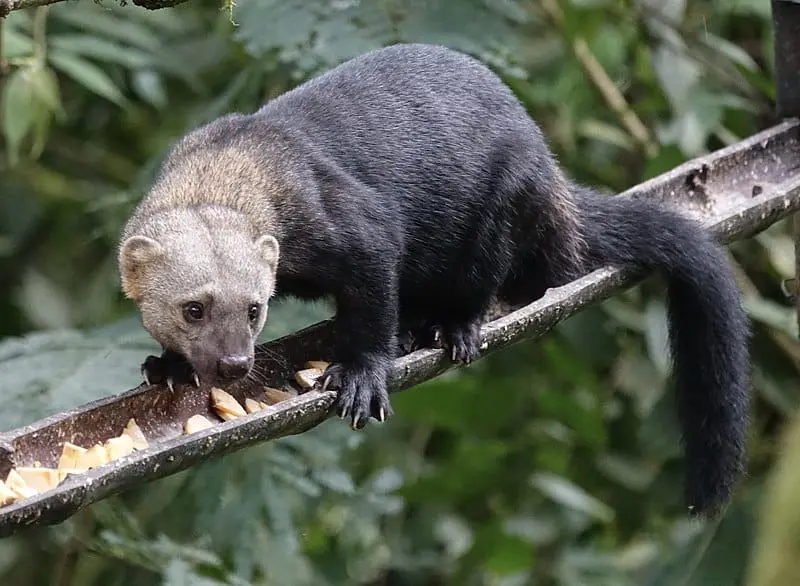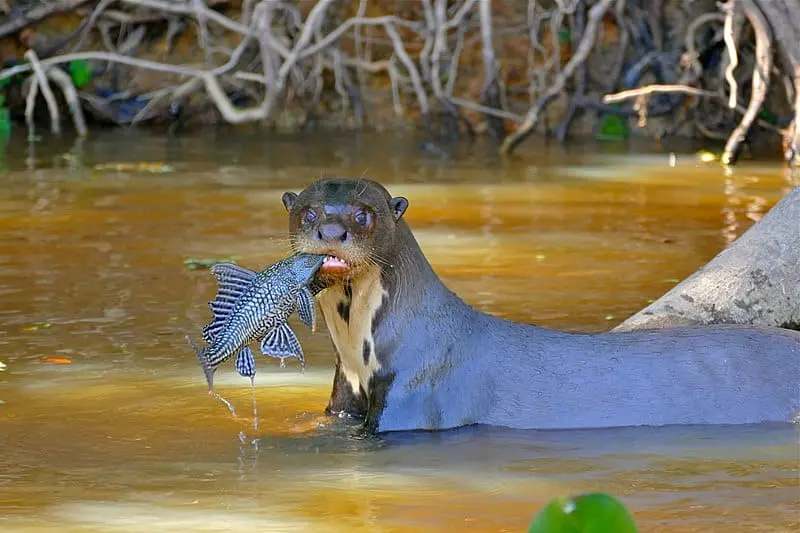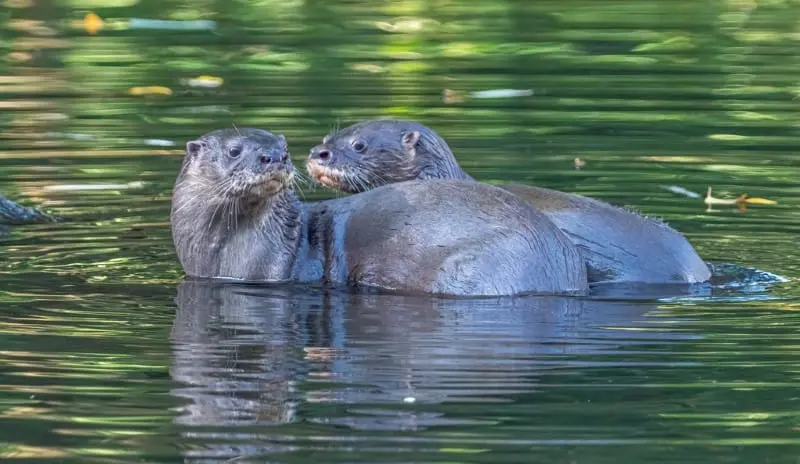Mustelids of Brazil
Mustelids are a family of carnivorous mammals that includes weasels, badgers, otters, ferrets, minks, and others. During evolution, several behavioral and physical adaptations have developed in each subfamily, and they have come to inhabit the most diverse environments including coastlines, mountains, rivers, and forests. Thus, mustelids can be terrestrial, living on the ground or in trees, or aquatic, living in rivers, lakes, or oceans.1
The smallest mustelids, such as the least weasel, can be less than 8 inches (20 cm) long, while the giant otter can reach 6 feet (1.8 m). Despite this variation in size, they all have similarly elongated bodies, short legs, small rounded ears, and thick fur.
With the exception of the sea otter, all have anal scent glands that produce a strong-smelling secretion used for sexual signaling and territorial marking. Despite sharing some characteristics, skunks are not members of the mustelid family. 2
The mustelid family is currently composed of 25 genera and about 67 species that inhabit almost all continents, forming the largest family of the order Carnivora. In Brazil, there are six species distributed throughout the country:
Greater grison (Galictis vittata) and lesser grison (G. cuja)

They are easily distinguished from other mustelids by their black lower body and gray upper body. From the head to the shoulders, there is a horizontal white band that separates the black and gray.
The greater grison and the lesser grison share many physical and behavioral characteristics: both are able to run and climb and are primarily terrestrial, but they also have legs with interdigital membranes that allow them (when necessary) to hunt efficiently in water. They feed mainly on rodents and small mammals. Besides birds, they also eat frogs , lizards, snakes and their eggs3 4.
The main difference between these two species is in size and distribution: the greater grison reaches up to 68 cm (27 in)2 and can be found in Central and South America; in Brazil, it inhabits the entire northern and northeastern regions — probably being the only mustelid present in the Caatinga. The lesser grison, on the other hand, measures about 42 cm (16.5 in) and is found throughout Brazil, except in the Amazon region. However, confirmed records of these species are scarce, so there are no accurate current estimates of their distribution.
Both species are listed by the (IUCN) as “Leas Concern” because they have a wide distribution and tolerate a certain degree of human disturbance. Despite this, they naturally have a low population density, and some subspecies are considered uncommon or rare.
Tayra (Eira barbara)

Tayras are found throughout most Central and South America. In Brazil, three of the seven subspecies can be found, being E. b. poliocephala and E. b. poliocephala, found in the Amazon, and E. b. poliocephala found in forests all over the country — except in the Caatinga and the Pampas.
They are easily distinguished from other mustelids by their unique coloration: the head is lighter than the rest of the body, with brownish or grayish tones that gradually darken to the shoulder region - though it is not uncommon to find albino, melanistic, or leucistic individuals. On the throat, each individual has a different yellowish spot that helps family members identify each other5.
Tayras are opportunistic animals that hunt small mammals, birds, lizards, and invertebrates. They also have interdigital membranes, but do not usually swim. Instead, they are great runners and tree climbers, where they feed on fruit and honey.6
Although the species is listed as “Low Concern” by the IUCN, wild iraras populations are slowly declining. The subspecies E. b. poliocephala, for example, is already classified as “Vulnerable”. The main causes of non-natural deaths are due to roadkill, disease transmission by domestic animals, forest fires, and conflicts with poultry farmers, beekeepers, and farmers.
Giant Otter (Pteronura brasiliensis)

Giant otters, also known as giant river otters, are the largest mustelids in the world, reaching up to 1.8 m (6 ft)2 and up to 34 kg (75 lb). Like tayras, they have spots on the throat that make each individual unique and aid in identification. On the other hand, they differ from other mustelids mainly by their large size, their paddle-shaped tail, and by being the only exclusively diurnal species among Brazilian mustelids.
Its feet are completely palmated and adapted to aquatic life. Therefore, it feeds mainly on fish, but can also eat turtles, crabs, snakes, and young alligators if there are not enough fish available. Giant otters are social and live in groups of three to seven individuals, consisting of parents and their adult cubs.
All otters emit sounds, but considering the volume and frequency, giant otters can be particularly loud, with a complex repertoire of warning vocalizations and calls. In addition, each family seems to have its own sound identity7.
It is one of the most endangered mammal species in Latin America. It once inhabited almost all of Brazil, from Amazonia to Rio Grande do Sul, except for the Caatinga biome. But poaching for their velvety skin between the 1940s and 1960s drastically reduced their numbers, and they were listed as " endangered" in 1999.
Today, giant otters have lost up to 80% of their range in South America and their numbers are estimated to be less than 5,000. The main causes of their current threats are habitat degradation and loss, overfishing, water pollution, diseases carried by domestic animals, retaliatory killing by fishermen, and the construction of hydroelectric dams.
Despite this, several conservation efforts have been made and, little by little, results have been achieved. According to research by biologist Natália Pimenta in 2018, giant otters are returning to inhabit the Içana River — where they had been extinct since 1940.8
Neotropical otter (Lontra longicaudis)

Also known as the neotropical river otter. They are adapted to aquatic life and have interdigital membranes that help them swim. They feed primarily on fish and crustaceans, which make up 67% and 28% of their diet, respectively, but may occasionally eat mollusks and small animals.
At first glance, these otters may look very similar to giant otters, but they are smaller (about 1 m (3 ft) long) and do not have neck patches. They also live in pairs or solitarily and do not usually form groups.
Like other large mustelids, it is part of the top of the food chain as an important animal for the entire aquatic ecosystem and is an indicator of good biological quality for the environment.
They live in Central and South America. In Brazil, they can be found in rivers, lakes and lagoons of all biomes, with the exception of the Caatinga. Each region of the country has a different status of the species, ranging from “low concern” to “vulnerable”. However, it is listed as “Near Threatened” by the IUCN.
Riparian areas are essential to their survival, as these are the places where they clean their fur, raise their young, rest and mark their territory. Therefore, water pollution and the removal of riparian forest can threaten otter populations by depriving them of the appropriate environment to carry out their basic activities.
Other factors affecting otter populations include illegal hunting, habitat destruction from mining and cattle ranching, accidental road kills, dam construction, and conflicts with fishermen for fish.9
Amazon weasel (Neogale africana)
The Amazon weasel is also known as the tropical weasel. It was first identified from a specimen in a museum that was mislabeled as coming from Africa, hence its scientific name includes “africana”. The Amazon weasel is the animal with the least information among all Brazilian carnivores - including free-living images.10 Although its distribution is uncertain, it has been recorded throughout most of the Amazon basin, in Ecuador and Peru.11 They measure 40 to 50 cm (16 to 20 in) in length.
It is a terrestrial species, but can climb as well as swim. Their diet consists mainly of rodents, but when there is a shortage of their natural prey or opportunity, Amazon weasels do not hesitate to attack captive chickens, rabbits, or other domestic animals, and are persecuted as pests in many rural areas.
Despite this, they are believed to inhabit a large area of the Amazon almost intact, so they are not susceptible to population decline, and their risk of extinction is low, so they are listed as " Low Concern" by the IUCN12 However, more research is needed to accurately determine their distribution and level of tolerance to human disturbance, as well as more information about the species.
Although it is not a threatened species, it can be inferred that increasing deforestation, habitat loss and alteration may pose major threats to the species in the future.
Read more at:
-
Análise Preliminar da Dieta do Furão Pequeno (<i>Galictis cuja</i>) na Região do Pampa Brasileiro — SIEPE ↩︎
-
Throat Patch Variation in Tayra (<i>Eira barbara</i>) and the Potential for Individual Identification in the Field — MDPI ↩︎
-
Predation by the Tayra (<i>Eira barbara</i>) — Journal of Mammalogy ↩︎
-
Territorial choruses of giant otter groups (Pteronura brasiliensis) encode information on group identity ↩︎
-
Levantamento bibliográfico sobre lontras (<i>Lontra longicaudis</i>) com ênfase às populações do Rio Grande do Sul, Brasil — ResearchGate ↩︎
